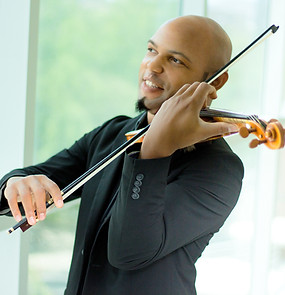
The 24 Caprices
3rd edition!
78 pages!
6 genres!
Performed at:
The Juilliard School
Spectrum NYC
Sphinx Virtuosi
Trio Jazz Center
Yoga Oasis
Arts at the Oscar:
University of Michigan
South Dakota State U.
ASTA


Dr. Immanuel Abraham
Performer • Composer • Educator • Author
Shoulder Rests:
Should We Use Them?

My Experience
I went most of my playing time without a modern shoulder rest.
I did always use a cloth, sometimes two, and sometimes two
with a piece of violin case liner.
It was a hassle, but automatic.
The violin was always up and ready
to create music before I ever diverted focus to a handkerchief.
I starting using a shoulder rest
when I began my doctorate in
Violin Performance. The physics
of shoulder rests just made too
much sense for me to ignore,
both anatomically and acoustically.
Unexpected improvements to my comfort did come immediately.
The "violin hickey", developing since the day I started playing, began to rapidly fade away as well. I have used a rest ever since, personally choosing the Pirastro Korfker Rest.
Practicality
There are as many different body shapes as there are people. Yet today, all adult violins are nearly the exact same size.
The culture of violin-family instruments having vast variation
in size and shape (like its evolutionary predecessors, the rebab, rebec, et al.) stopped for many reasons.
Many say this occurred in the early 16th century with the acclaimed instruments of Andrea Amati (1505-1577).
While electric violins have returned to yielding broader options for size and shape, acoustic designs are mandatorily limited in this area.
Acoustic violin specialists depend upon a consistent, standardized shape and size for; pitch, technique, and timbre.
The Rest Conspiracy
I still always say, "Bring the violin
to fit the performer, don't break the performer to fit the violin."
Acoustic violin dimensions being largely standardized today makes body-accommodating accessories
(like chin and shoulder rests)
the ways to do so.
Some believe that everyone should play without a shoulder rest.
Some insist that their students and colleagues never use one.
Chin rests had the same reaction as their design emerged in the 19th century.
Today, however, there are several thousands of chin rest designs and entire businesses who custom make them. I hardly know a player without one.
20th Century Players
With an intent to discourage shoulder rests, the same dozen 20th century violinists (Nathan Milstein, Yehudi Menuhin, Henryk Szeryng, Jascha Heifetz, etc.) are alleged as examples who did not use shoulder rests. I find this is a major conceptual error.
I will always count rolled-up cloths, shaped pads, and sponges set on our shoulders under our attire
and used for the same purpose, as shoulder rests.
They did not have today’s designs. In that case, I would still be using a cloth or a sponge myself.
Saying that a shoulder sponge is not a rest for the shoulder is gaslighting artists that a walking stick is not a cane.
All of the idolized examples did indeed each use one of the above mentioned body-accommodations,
every single time.
What Should I Use?
For a relatively low neck, wider shoulder span, and wider mandible
like Itzhak Perlman's, these physical features all support the instrument,
ergo a rolled up cloth suffices.
For a longer neck, leaner shoulder span, and leaner mandible
like Leonidas Kavakos', his instrument will fall if he relaxes upon it alone without extra efforts. A low shoulder rest to slightly raise the violin and omit unnecessary lean or strain, supports the player.
For someone in between, like Augustin Hadelich, an in-the-attire
sponge makes the most sense,
which is exactly what he uses.
I am 6ft, 1in with a longer neck, wider shoulder span, and a wide mandible.
I use a low Pirastro Korfker with both feet twisted into their lowest setting, and the shortest foot option chosen for both sides. This is combined with a high, side-mount chin rest.
Conclusion
Everyone has a different neck, differently shaped shoulders,
different mandibles, and
different shoulder blades.
Our instrument very rarely changes size or shape to accommodate that.
Did you know that the average career violinist plays the violin for more minutes than we walk per day?
Urging all violinists to play without a shoulder rest is urging all runners to perform wearing the same size shoe.
As the physical diversity of violinists and violists broadens, so should the use of our body-accommodating accessories.
I believe shoulder rests, including sponges and layered cloths, are the healthy way for most to play.
Bring the violin to fit the performer,
don't break the performer to fit the violin.






